Nearly half of Americans think the US is spending too much on Ukraine aid, an AP-NORC poll says
SEUNG MIN KIM and LINLEY SANDERS
Tue, November 21, 2023

Ukrainian soldiers navigate on the Dnipro river by boat at the frontline near Kherson, Ukraine, Sunday, June 11, 2023. (AP Photo/Felipe Dana) (ASSOCIATED PRESS)
WASHINGTON (AP) — As lawmakers in Washington weigh sending billions more in federal support to Kyiv to help fight off Russian aggression, close to half of the U.S. public thinks the country is spending too much on aid to Ukraine, according to polling from The Associated Press-NORC Center for Public Affairs Research.
Those sentiments, driven primarily by Republicans, help explain the hardening opposition among conservative GOP lawmakers on Capitol Hill who are rebuffing efforts from President Joe Biden to approve a new tranche of Ukraine aid, arguing that the money would be better spent for domestic priorities.
Yet opposition to aid is down slightly from where it was a month ago in another AP-NORC poll. Now, 45% say the U.S. government is spending too much on aid to Ukraine in the war against Russia, compared with 52% in October. That shift appears to come mostly from Republicans: 59% now say too much is spent on Ukraine aid, but that’s down from 69% in October.
Nonetheless, the Republican resistance to continued Ukraine aid remains strong.
“I understand the citizens need help, but I feel like we’re spending way too much money on Ukraine when we have our issues here, on our own soil, that we need to deal with,” said Eric Mondello, 40, from Fountain, Colorado. Pointing to needs such as health care for veterans and homelessness in communities, Mondello added: “I understand the U.S. has been an ally to others, but I feel like, let’s take care of our people first.”
More than one-third (38%) of U.S. adults say that current spending is “about the right amount,” which is up slightly from last month (31%). Among Republicans, nearly 3 in 10 (29%) say the current spending is about right, up from 20% last month.
Paula Graves, 69, is among those who says the amount of spending for Ukraine is the right amount.
“Putin, he’s straight up evil. I don’t think there should be any question in anyone’s mind,” said Graves, of Clovis, California. "He’s a dictator. He’s infringed on human rights, he’s a very scary person and if Ukraine falls to him, who’s next? What country’s next?”
Graves, who says she is not affiliated with a political party but leans more conservative, said she believes the U.S. has a leadership role on the global stage and added: “I think we definitely need to put America first, but I don’t think that needs to be first and only.”
The White House has been repeatedly pressing lawmakers to pass Biden’s nearly $106 billion emergency spending package that he proposed in October, which includes more than $61 billion specifically for the war in Ukraine. The rest of Biden’s request has aid for Israel as it battles Hamas, money for various priorities in the Indo-Pacific region and additional resources to help manage migration at the southern border.
On Ukraine, the Biden administration is increasingly warning that the well of aid is running dry. In an unannounced visit to Kyiv on Monday, Defense Secretary Lloyd Austin said Ukraine’s effort to defeat Russian forces “matters to the rest of the world” and pledged that U.S. support would continue “for the long haul.”
That message was reinforced at the White House.
“As President Biden has said, when aggressors don’t pay a price for their aggression, they’ll cause more chaos and death and destruction," John Kirby, spokesman for the National Security Council, told the White House press briefing Monday. “They just keep on going, and the cost and the threats to America and to the world will keep rising.”
But Congress has rebuffed the White House efforts at bolstering Ukraine support at least twice in recent months. First, it ignored a roughly $40 billion supplemental request before a Sept. 30 funding deadline. Then last week, it passed a stopgap funding measure that keeps the government operating through early next year, but with no additional Ukraine aid.
In the Senate, a small bipartisan group is working on legislation that would combine fresh Ukraine assistance with stricter border measures to address concerns from Republicans that the U.S. was focused on needs abroad at the expense of issues closer to home. A broad majority of senators remains supportive of Ukraine aid, with Senate Minority Leader Mitch McConnell, R-Ky., being one of the most stalwart supporters despite the isolationist strain in his party.
South Dakota Sen. John Thune, the No. 2 Republican in the Senate, said lawmakers will continue to work on the Ukraine-border package over the Thanksgiving break and won't wait until mid-January — when Congress faces another government funding deadline — to act on Ukraine.
The big question mark is in the House, where still-new Speaker Mike Johnson — who had voted against Ukraine aid as a rank-and-file conservative — has spoken broadly of the need to counter Russian aggression yet faces unruly GOP lawmakers who have shown more hostility to continued support for Kyiv.
Johnson, too, is insisting that additional Ukraine aid be paired with tougher border measures, although it is far from certain that any immigration agreement that clears the Democratic-led Senate could pass the GOP-controlled House.
Half of U.S. adults are extremely or very concerned that Russia’s influence poses a direct threat to the United States. Democrats (53%) and Republicans (51%) are similarly concerned about Russian power – but Democrats are more likely than Republicans to see Ukraine as a nation of shared values to the U.S. and to support more aid for Ukraine.
About half of the public (48%) endorses providing weapons to Ukraine (57% among Democrats, 42% among Republicans). About 4 in 10 favor sending government funds directly to Ukraine (54% for Democrats, 24% for Republicans).
Americans have grown slightly more likely to say the U.S. should take “a less active role” in solving the world’s problems, compared with a September poll from AP-NORC and Pearson. Slightly fewer than half (45%) now say the U.S. should be less involved, up from 33% in September. Just 16% of Democrats now say the U.S. should take a more active role, down from 29% in September.
Peter Einsig, a Republican from Tulsa, Oklahoma, said he still believes the U.S. has a role to play abroad, but that he remains concerned about excessive government spending and federal debt.
Yet Einsig said he would be more inclined to support aid to Ukraine if there were more oversight into how the money was being used abroad, as well as a timeline of how much longer the U.S. would be providing support.
“We don’t have transparency on where the money is really, really going,” said Einsig, 40. “It’s a big lump sum.”
Four in 10 U.S. adults say Ukraine is an ally that shares U.S. interests and values. That view is most common among Democrats (53%), who are much more likely than independents (28%), Republicans (29%) and Americans overall to see Ukraine as a nation with similar values and needs. About half of Republicans say Ukraine is a partner that the U.S. should cooperate with, but say it is not a nation that shares U.S. values.
___
The poll of 1,239 adults was conducted Nov. 2-6, 2023, using a sample drawn from NORC’s probability-based AmeriSpeak Panel, designed to represent the U.S. population. The margin of sampling error for all respondents is plus or minus 3.9 percentage points.
10 years later, a war-weary Ukraine reflects on events that began its collision course with Russia
KYIV, Ukraine (AP) — It happens every November, when the cold descends on Kyiv. The change in weather always makes Dmytro Riznychenko think back, and he is overwhelmed by his emotions.
“This is where it truly began," Riznychenko said, walking through central Kyiv's Independence Square recently, reflecting on the uprising that unleashed a decade of momentous change for Ukraine, eventually leading to the current war with Russia.
"Ten years of war and struggle,” the 41-year-old psychologist continued, wearily and reluctantly. “And it seems like the blood has only just begun to flow, truly. I regret nothing. But, God, it’s just so tiresome.”
On Nov. 21, 2013, the Moscow-friendly president of Ukraine, Viktor Yanukovych, announced he was shelving an agreement to bring the country closer to the European Union and instead would deepen ties with President Vladimir Putin’s Russia.
Outraged crowds soon filled Independence Square for peaceful anti-government protests. Later, after riot police used truncheons and tear gas to disperse the people, demonstrators set up tent camps with barricades, self-defense units and banners with revolutionary slogans. In response to the police violence, hundreds of thousands joined the demonstrations in early December.
The standoff reached a climax in February 2014, when police unleashed a brutal crackdown on the protests and dozens of people were slain between Feb. 18-21, many by police snipers. A European-mediated peace deal between the government and protest leaders envisioned the formation of a transition government and holding an early election, but demonstrators later seized government buildings, and Yanukovych fled to Russia.
The Ukrainian Institute of National Remembrance said 107 people were killed in the uprising.
Kateryna Gladka was a 23-year-old student when she joined the pro-Western crowds at the time, viewing it as the “revolution of her generation.”
“For me, the top priority was the value of freedom, basic freedom, and dignity.”
“We had to prevent a totalitarian regime and the return of Soviet things,” Gladka said in a telephone interview.
She recalls the police violence and blood staining the street near Independence Square, and “I very clearly understood that we had entered another stage.”
After Yanukovych's ouster, Russia responded in March 2014 by illegally annexing Ukraine's Crimean Peninsula. Then, separatist forces backed by Moscow began an uprising in the eastern Ukraine region known as the Donbas, which grew into a long-running conflict, leaving thousands dead.
Finally, in February 2022, Putin launched his war that continues to this day, with tens of thousands of deaths on both sides amid Europe's biggest conflict since World War II.
“Yanukovych was that puppet, a figure for Moscow, which hoped to use him as a person to keep Ukraine on the Russian leash,” said Kateryna Zarembo, an analyst at the Kyiv-based think tank, The New Europe Center. “When he fled, it became clear to the Kremlin that they were losing Ukraine.”
Asked Tuesday about the 10th anniversary of the start of the uprising in Kyiv, Kremlin spokesman Dmitry Peskov reiterated Russia’s view that it was “a coup, a forceful coup financed from abroad.”
Ukrainians in 2013 had wanted the country to enter into a deal with the EU, but Putin pressured Yanukovych to pull out at the last minute. Ukrainian leaders who followed were more eager than ever to bring Kyiv into the Western fold.
“So what we saw in 2022 — that Ukraine had to be either part of Russia or destroyed — those intentions were seen earlier," Zarembo said. "When that didn’t happen, Russia intervened militarily.”
Despite the calamities, Ukraine has become more united than in its 32 years of independence and has drawn closer to the EU, the United States and the West in general — an outcome Putin had tried to prevent. Today, under President Volodymyr Zelenskyy, the country has won widespread support and admiration amid the Russian invasion.
“All of this came at a very high cost,” Riznychenko said.
Standing on the Alley of Heavenly Hundred, so named to honor those killed in the uprising, he recalled the sniper fire from a special police unit known as Berkut, which was disbanded in 2014.
“There was a feeling that death had opened its arms,” Riznychenko said.
“It was cold, I remember how the dead were lying. I remember them under blankets near the Main Post Office. That I remember,” he added.
Now, their portraits are on permanent display on the street honoring those slain in what Ukraine calls its Revolution of Dignity, and Riznychenko said he later memorized the names. In 2014, he volunteered to fight in eastern Ukraine against the Moscow-backed separatists, and was injured in Ilovaisk.
Investigations of the shootings are continuing, and the Prosecutor General’s Office recently indicted five members of the Berkut police unit, all now living in Russia. Another 35 people are being investigated.
Independence Square today also features a multitude of small blue-and-yellow flags, with each symbolizing a fallen soldier in the war. Their numbers grow daily.
Every year, Gladka gathers with friends at a nearby restaurant, aptly named The Last Barricade, to commemorate the uprising. But after 21 months of war with Russia, the date brings conflicting emotions.
“To be honest, I am personally very tired of the fact that every generation has to die for Ukraine,” she said, noting that 10 years of her youth have been stained by violence, and she now wants a “normal and ordinary life.”
“This endless struggle is like some closed circle that just lasts for centuries,” she said.
___
Associated Press photographer Efrem Lukatsky contributed
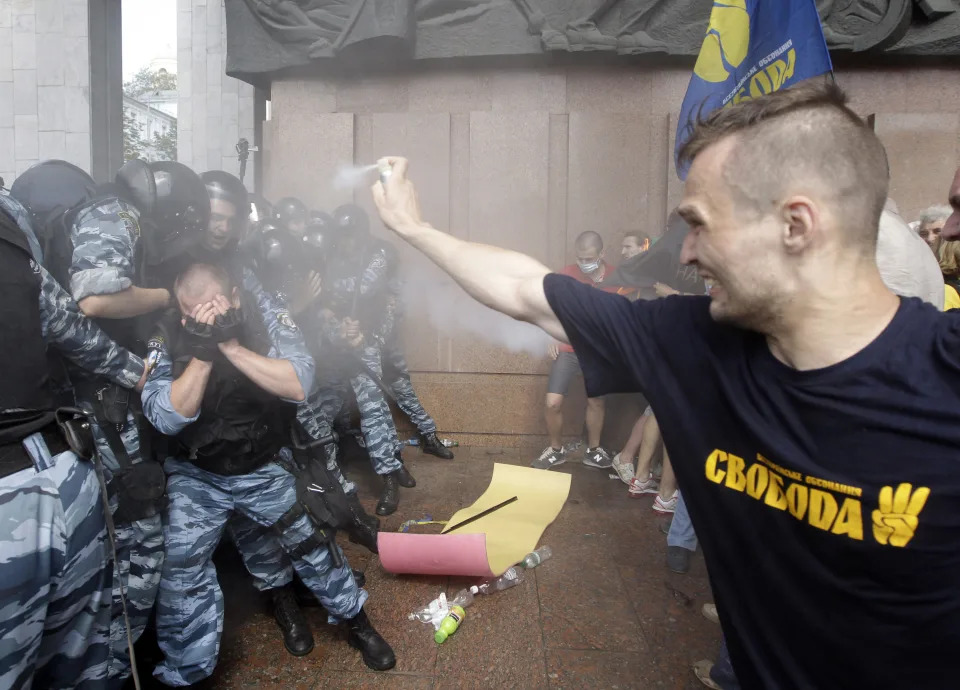

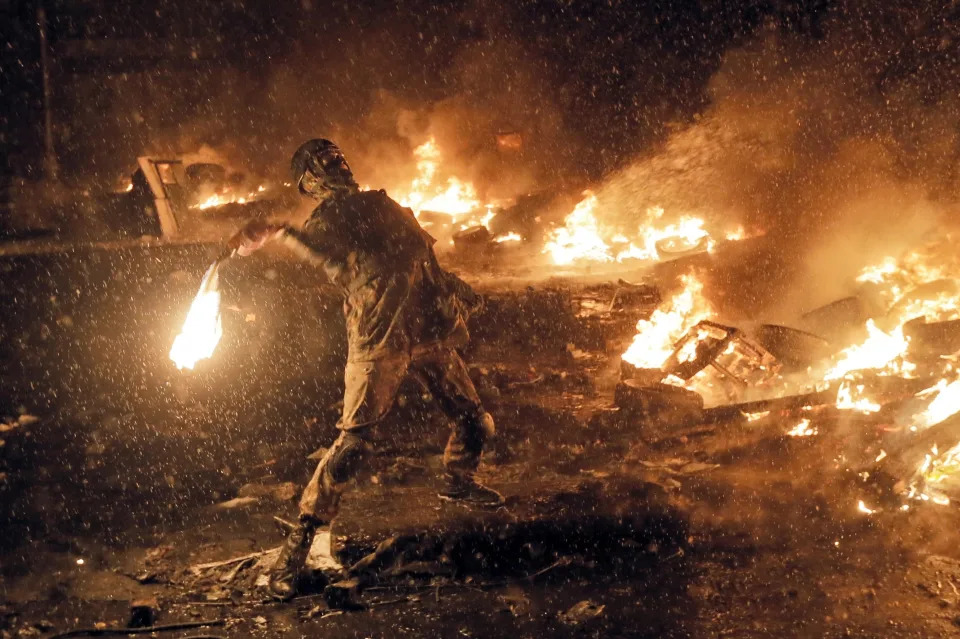


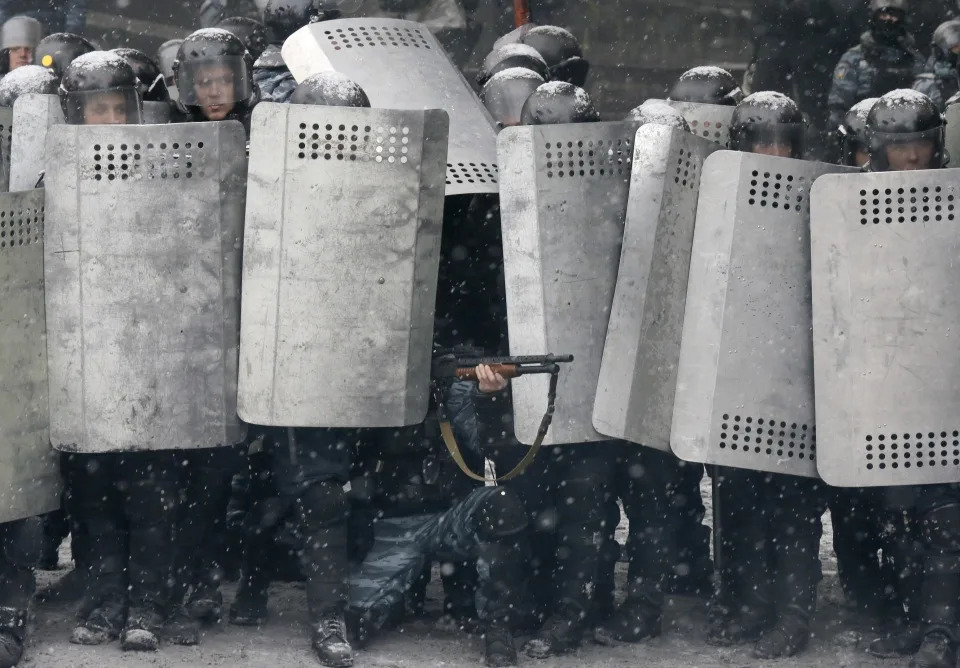


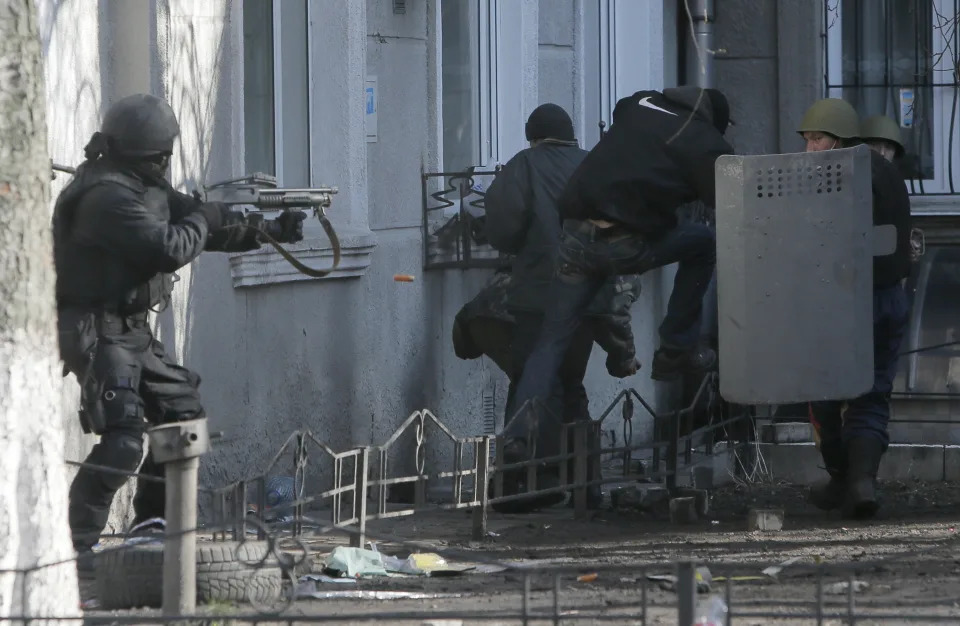
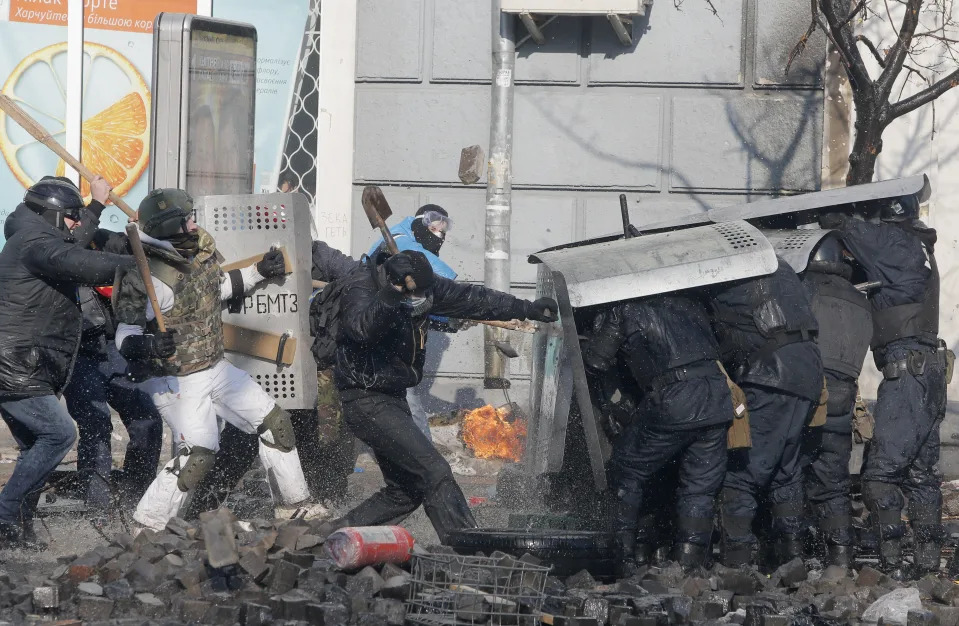

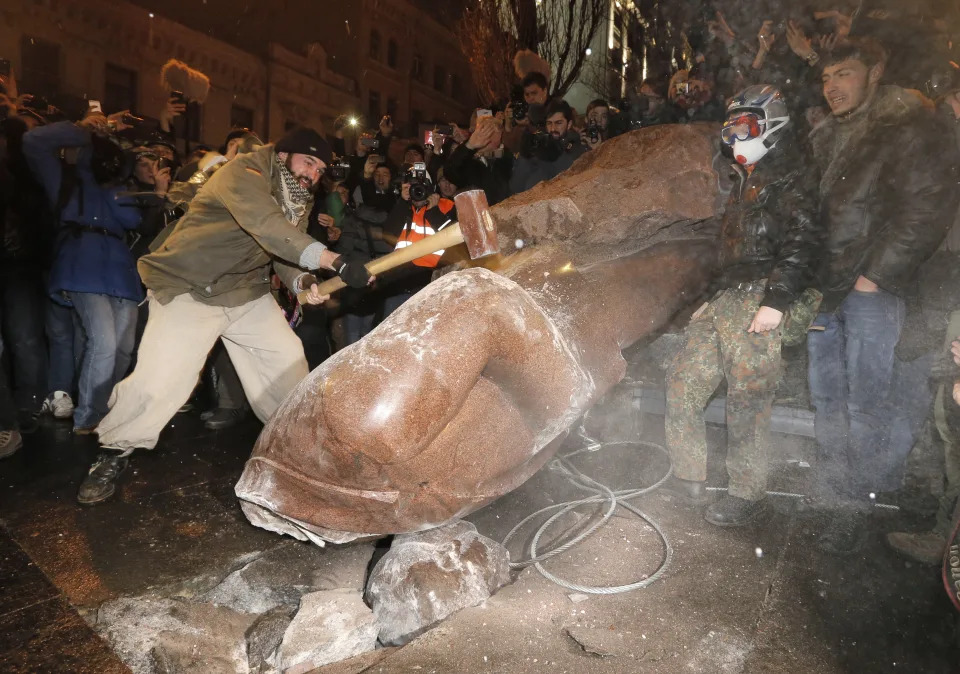
Ukraine Uprising Anniversary
In this file photo taken on Dec. 8, 2013, Ukrainians break a monument to Vladimir Lenin in central Kyiv, Ukraine on Dec. 8, 2013. On Nov. 21, 2023, Ukraine marks the 10th anniversary of the uprising that eventually led to the ouster of the country’s Moscow-friendly president.

No comments:
Post a Comment